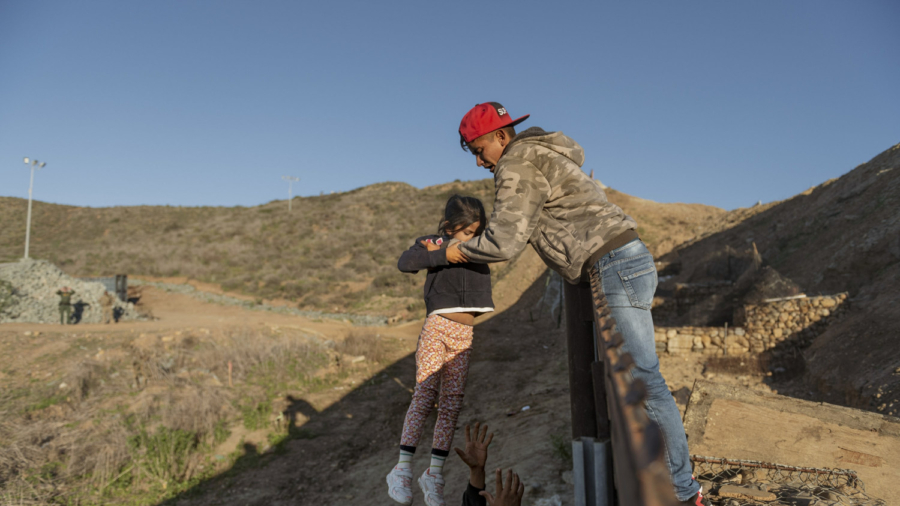SAN DIEGO—The Trump administration on Jan. 29, launched an effort to make asylum seekers wait in Mexico while their cases wind through U.S. immigration courts.
The effort, called the Migrant Protection Protocols (MPP), is an attempt to rein in meritless asylum claims and stop thousands of illegal immigrants from being released into the country, never to be seen again.
The United States returned one Honduran asylum seeker to Mexico under the new policy. Carlos Gomez, 55, arrived in Tijuana around midday and asked authorities for a ride to a migrant shelter.
Mexican officials sent mixed signals on the crucial point of whether Mexico would impose limits on accepting families. Tonatiuh Guillen, the commissioner of Mexico’s National Immigration Institute, said Mexico would only accept people 18 to 60 years old, which rules out families with young children.
But Roberto Velasco, spokesman for Mexico’s foreign relations secretary, said Friday, Jan. 25, that families would be considered case by case.
The launch is limited to San Diego’s San Ysidro border crossing, the nation’s busiest, though Customs and Border Protection Commissioner Kevin McAleenan wrote in a memo released Tuesday that it is expected to expand to other crossings “in the near future.” Adding to a sense of confusion, Guillen said Mexico will only allow it at the one crossing that connects San Diego and Tijuana.

Katie Waldman, a Department of Homeland Security spokeswoman, insisted families will be included. A sharp increase in Central American families seeking asylum in the United States led to the Trump administration’s decision, and limiting families would diminish the impact.
“It will be expanded across the entire Southwest border, and it will apply to family groups,” Waldman said.

Homeland Security Secretary Kirstjen Nielsen was in San Diego on Tuesday to observe the launch but had no public appearances. The U.S. Embassy in Mexico said in a news release that the program began Tuesday.
Mexico’s foreign relations secretary said Friday that the United States would start with 20 people a day. Two U.S. officials, who spoke on condition of anonymity because the deliberations were not public, said shortly before the launch that the policy would start with about 100 people a week in a trial period of up to 90 days in San Diego.
The launch followed months of delicate talks between the United States and Mexico and marked a change to the U.S. asylum system that both the administration and asylum experts said was unprecedented.

On Monday, U.S. Citizenship and Immigration Services said in a memo to employees that asylum officers would interview migrants to determine if they are “more likely than not” to be persecuted or tortured in Mexico while waiting for hearings in the United States. If they are not, they will be returned to Mexico.
Asylum seekers will not be allowed to have attorneys at that initial screening held at border crossings “given the limited capacity and resources,” drawing swift criticism from immigration attorneys.
“With this policy, the Trump administration is purposefully keeping Central Americans in unsafe conditions without access to counsel and evidence in an effort to send them straight back to the hands of their persecutors,” Dree Collopy, an immigration lawyer in Washington, wrote in an email.
Due largely to a court-imposed 20-day limit on detaining children, families are typically released in the United States with a notice to appear in illegal immigration court. With a backlog of more than 800,000 cases, it can take years to settle cases.

Nielsen said last week that the “migrant protection protocols” being introduced in San Diego are a “methodical commonsense” approach to a humanitarian and security crisis on the Mexican border.
“For far too long, our immigration system has been exploited by smugglers, traffickers and those who have no legal right to remain in the United States,” she said.
Children traveling alone and Mexican asylum seekers will be exempt from the program, as will criminals, people with a history of violence, and those with physical or mental health issues, according to guidelines issued Tuesday by Customs and Border Protection.
Customs and Border Protection said asylum seekers would be given a sheet with information on the process and a list of free or low-cost legal service providers. U.S. authorities will provide transportation between the border and the courtroom.
Guillen said Mexico’s temporary visas would last for a maximum of 120 days. The Mexican official said U.S. asylum judges are expected to render final decisions within 90 days.
By Elliot Spagat

